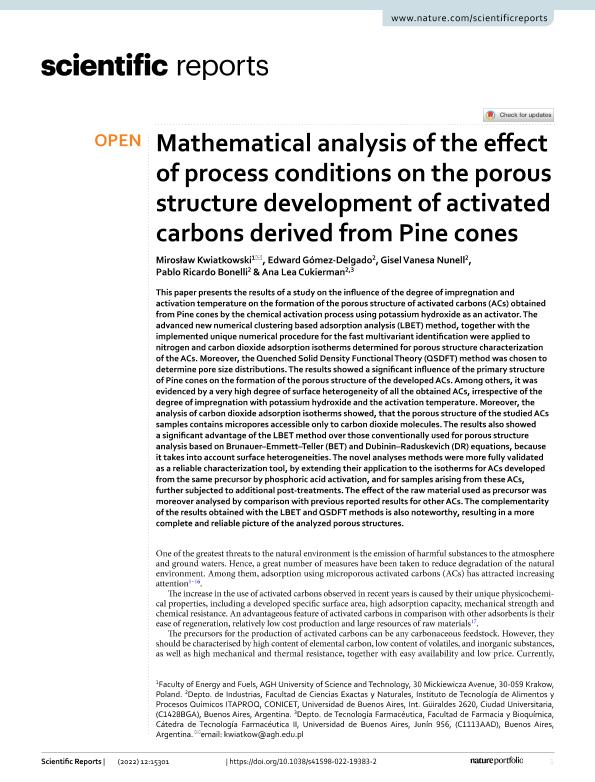Mostrar el registro sencillo del ítem
dc.contributor.author
Kwiatkowski, Kwiatkowski
dc.contributor.author
Gomez Delgado, Edward Enrique

dc.contributor.author
Nunell, Gisel Vanesa

dc.contributor.author
Bonelli, Pablo Ricardo

dc.contributor.author
Cukierman, Ana Lea

dc.date.available
2023-10-03T09:59:59Z
dc.date.issued
2022-09
dc.identifier.citation
Kwiatkowski, Kwiatkowski; Gomez Delgado, Edward Enrique; Nunell, Gisel Vanesa; Bonelli, Pablo Ricardo; Cukierman, Ana Lea; Mathematical analysis of the effect of process conditions on the porous structure development of activated carbons derived from Pine cones; Nature; Scientific Reports; 12; 1; 9-2022; 1-16
dc.identifier.issn
2045-2322
dc.identifier.uri
http://hdl.handle.net/11336/213861
dc.description.abstract
This paper presents the results of a study on the influence of the degree of impregnation and activation temperature on the formation of the porous structure of activated carbons (ACs) obtained from Pine cones by the chemical activation process using potassium hydroxide as an activator. The advanced new numerical clustering based adsorption analysis (LBET) method, together with the implemented unique numerical procedure for the fast multivariant identification were applied to nitrogen and carbon dioxide adsorption isotherms determined for porous structure characterization of the ACs. Moreover, the Quenched Solid Density Functional Theory (QSDFT) method was chosen to determine pore size distributions. The results showed a significant influence of the primary structure of Pine cones on the formation of the porous structure of the developed ACs. Among others, it was evidenced by a very high degree of surface heterogeneity of all the obtained ACs, irrespective of the degree of impregnation with potassium hydroxide and the activation temperature. Moreover, the analysis of carbon dioxide adsorption isotherms showed, that the porous structure of the studied ACs samples contains micropores accessible only to carbon dioxide molecules. The results also showed a significant advantage of the LBET method over those conventionally used for porous structure analysis based on Brunauer–Emmett–Teller (BET) and Dubinin–Raduskevich (DR) equations, because it takes into account surface heterogeneities. The novel analyses methods were more fully validated as a reliable characterization tool, by extending their application to the isotherms for ACs developed from the same precursor by phosphoric acid activation, and for samples arising from these ACs, further subjected to additional post-treatments. The effect of the raw material used as precursor was moreover analysed by comparison with previous reported results for other ACs. The complementarity of the results obtained with the LBET and QSDFT methods is also noteworthy, resulting in a more complete and reliable picture of the analyzed porous structures.
dc.format
application/pdf
dc.language.iso
eng
dc.publisher
Nature

dc.rights
info:eu-repo/semantics/openAccess
dc.rights.uri
https://creativecommons.org/licenses/by/2.5/ar/
dc.subject
POROUS CARBONS
dc.subject
TEXTURAL PROPERTIES
dc.subject
NUMERICAL ANALYSIS
dc.subject
ADSORPTION
dc.subject.classification
Ingeniería de Procesos Químicos

dc.subject.classification
Ingeniería Química

dc.subject.classification
INGENIERÍAS Y TECNOLOGÍAS

dc.title
Mathematical analysis of the effect of process conditions on the porous structure development of activated carbons derived from Pine cones
dc.type
info:eu-repo/semantics/article
dc.type
info:ar-repo/semantics/artículo
dc.type
info:eu-repo/semantics/publishedVersion
dc.date.updated
2023-07-07T22:41:23Z
dc.journal.volume
12
dc.journal.number
1
dc.journal.pagination
1-16
dc.journal.pais
Reino Unido

dc.journal.ciudad
London
dc.description.fil
Fil: Kwiatkowski, Kwiatkowski. AGH University of Science and Technology; Polonia
dc.description.fil
Fil: Gomez Delgado, Edward Enrique. Universidad de Buenos Aires. Facultad de Ciencias Exactas y Naturales. Departamento de Industrias. Instituto de Tecnología de Alimentos y Procesos Quimicos. Consejo Nacional de Investigaciones Científicas y Técnicas. Oficina de Coordinación Administrativa Ciudad Universitaria. Instituto de Tecnología de Alimentos y Procesos Quimicos.; Argentina
dc.description.fil
Fil: Nunell, Gisel Vanesa. Universidad de Buenos Aires. Facultad de Ciencias Exactas y Naturales. Departamento de Industrias. Instituto de Tecnología de Alimentos y Procesos Quimicos. Consejo Nacional de Investigaciones Científicas y Técnicas. Oficina de Coordinación Administrativa Ciudad Universitaria. Instituto de Tecnología de Alimentos y Procesos Quimicos.; Argentina
dc.description.fil
Fil: Bonelli, Pablo Ricardo. Universidad de Buenos Aires. Facultad de Ciencias Exactas y Naturales. Departamento de Industrias. Instituto de Tecnología de Alimentos y Procesos Quimicos. Consejo Nacional de Investigaciones Científicas y Técnicas. Oficina de Coordinación Administrativa Ciudad Universitaria. Instituto de Tecnología de Alimentos y Procesos Quimicos.; Argentina
dc.description.fil
Fil: Cukierman, Ana Lea. Universidad de Buenos Aires. Facultad de Ciencias Exactas y Naturales. Departamento de Industrias. Instituto de Tecnología de Alimentos y Procesos Quimicos. Consejo Nacional de Investigaciones Científicas y Técnicas. Oficina de Coordinación Administrativa Ciudad Universitaria. Instituto de Tecnología de Alimentos y Procesos Quimicos.; Argentina
dc.journal.title
Scientific Reports
dc.relation.alternativeid
info:eu-repo/semantics/altIdentifier/url/https://www.nature.com/articles/s41598-022-19383-2
dc.relation.alternativeid
info:eu-repo/semantics/altIdentifier/doi/http://dx.doi.org/10.1038/s41598-022-19383-2
Archivos asociados
